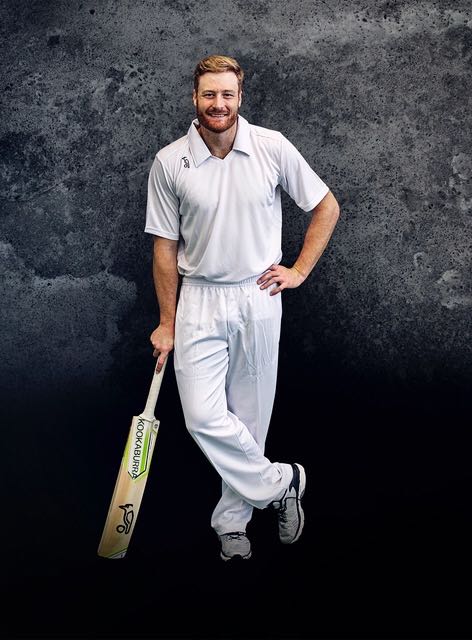How physiotherapist Brendan Wilson empowered opening batsman and international cricketer, Martin Guptill, to use IMU Step to increase athlete recovery buy-in during his return-to-performance journey
Playing cricket at the highest level of the game can be extremely challenging, with the top players in high demand from different leagues all over the world. Playing at this intensity during extended seasons can put stress on a player’s limbs and joints. This can hinder their potential injury or off-season recovery, which is why athlete recovery buy-in is crucial throughout the whole year. For those less familiar with cricket, there are numerous forms of the game: first class cricket, limited overs cricket, and Twenty20 cricket. These different forms of the game vary in match length, with first class cricket lasting up to five days and Twenty20 lasting an evening. International players are centrally contracted, but between matches, they can sign contracts with teams all over the world, each with varying time commitments.
Renowned opening batsman and international cricketer, Martin Guptill, has made 169 limited overs appearances for his country and this season has signed contracts with Sunrisers Hyderabad in the Indian Premier League (IPL), as well as 2018 English Twenty20 blast champions, Worcestershire, and in his home country’s domestic league. The high number of games played by international cricketers can often lead to soft tissue injuries.
“Cricket is unique in that although players are affiliated to their domestic team, our international players are centrally contracted and that means we may go months without seeing them. A system like IMU Step helps us collect ongoing, objective data on our players wherever they are in the world so when they do return to us, we have a really clear idea of where they are at physically.”
– Brendan Wilson

On the back of a busy 2018 season, Martin had returned from the Caribbean Premier League (CPL) with both a lingering hamstring injury and a fresh soleus injury. His domestic team physio, Brendan Wilson, was keen to avoid further injuries and ensure that Martin made a successful return to performance. Brendan also ensured Martin had enough athlete recovery buy-in to facilitate his own recovery outside their sessions.
“Martin had been speaking to Shane Bond about using IMU Step after Shane had used the technology with the national squad in their pre-season tour to the United Arab Emirates (UAE),” Brendan said. “We were in the offseason and although we didn’t have a major to rush to get Martin back, due to him having a few hamstring and soleus problems in the past, we wanted to explore every avenue to make sure we got Martin back fit.”
Their team had recently invested in GPS tracking technology to monitor overall workloads across the squad. However, they felt that IMU Step would offer deeper insights not only on the field but also in more controlled rehab exercises.
“Given Martin’s soft tissue injury, we weren’t initially concerned too much with the bone load data and focused our attention on the asymmetry data available in the IMU Step software. However, as we built our data set, the cumulative step load metrics became really useful for us to be able to look back retrospectively week to week and see if our periodization of intensity married up with what actually took place,” Brendan continued. “We identified days in the week where we wanted the work to be high intensity and others where we wanted to ease off. The IMU Step dashboard allowed us to view this really easily.”

Their team had recently invested in GPS tracking technology to monitor overall workloads across the squad. However, they felt that IMU Step would offer deeper insights not only on the field but also in more controlled rehab exercises.
Because asymmetry data was the key metric that Brendan was looking at, it was imperative that Martin wore the sensors in the gym as well as on the field, especially in the early stages of rehabilitation when they were predominantly indoors. This meant that Martin’s athlete recovery buy-in needed to be 100%.
“We did a lot of work early in the return-to-play process focusing on low-level plyometric work, force absorption work, and jumping and landing tasks. We were able to get an objective view of how Martin was loading in his injured vs his non-injured leg. As we added more complex exercises to his program, we were able to see how his asymmetry differed. We naturally found that as the complexity and intensity of the exercise increased, asymmetry increased. However, as Martin adjusted to the new stimulus, we saw that discrepancy reduce. Because of this data, we were able to determine when we should progress the exercise and when we needed a little more time to adjust.”

“The cumulative step load metrics became really useful for us to be able to look back retrospectively week to week and see if our periodization of intensity married up with what actually took place”.
“We were able to integrate IMU Step with our video which gave us real clarity on what was happening during certain exercises. Previously we would have looked at the video and seen things that we thought were happening, but having the data to back up what we were seeing gave us real confidence”, said Brendan. “I have recently looked over the data in IMU Step and saw that as we progressed through the rehabilitation process, asymmetries gradually came down throughout, which shows we were doing something right.”
“As we progressed through the athlete rehabilitation process, asymmetries gradually came down throughout, which shows we were doing something right”.

Brendan is one of only two staff members on the medical and performance team. To maximize their time and increase athlete recovery buy-in, Martin took on the responsibility of downloading his data on a day-to-day basis himself, allowing Brendan to focus on the analysis, programming, and planning. Now Martin is back playing in various competitions all over the world, he is still wearing the sensors in training. Having a simple downloading process and access to a cloud-based system allows Martin to download the data after use and upload to the IMU Step online platform where Brendan keeps track of asymmetry and workload data remotely.
“Cricket is unique in that although players are affiliated to their domestic team, our international players are centrally contracted and that means we may go months without seeing them. A system like IMU Step helps us collect ongoing, objective data on our players wherever they are in the world so when they do return to us, we have a really clear idea of where they are at physically. It also increases the awareness of their own injury and consistent athlete recovery buy-in. Should an injury then happen, we have a bank of baseline data which allows us to be really specific and prescriptive in the rehabilitation process that follows.”

“Martin took on the responsibility of downloading his data on a day-to-day basis himself, allowing [physiotherapist] Brendan to focus on the analysis, programming, and planning”.
“Here in Auckland, we push athlete empowerment and self-sufficiency. Martin was involved in the data collection and analysis right from the start and was happy to be responsible for ensuring he wore the sensors every day and also for downloading the data after each session”. Brendan said. “Because of the IMU Step online platform, Martin could download the data and upload it to the account I had access to, so we could assess how that day had gone. Having Martin so invested in the process really helped the athlete recovery buy-in we experienced using IMU Step”




